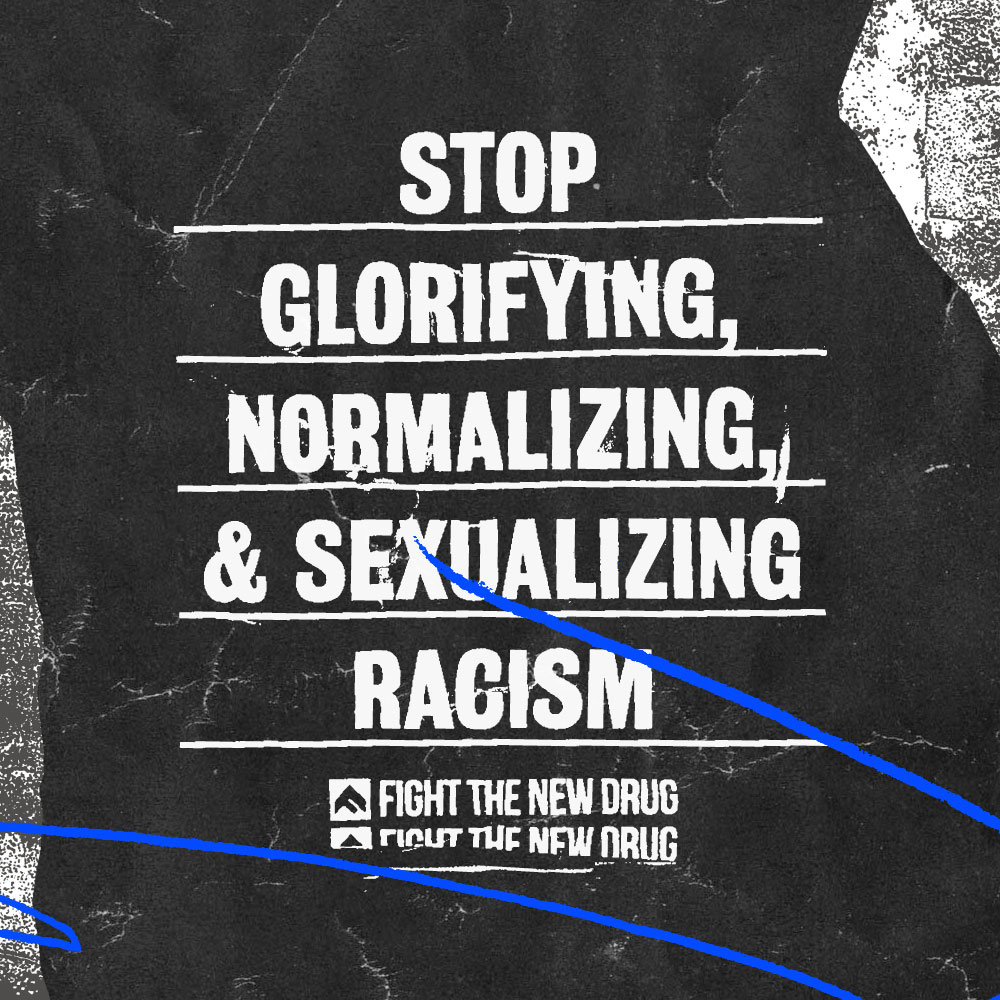Did you know that pornography has the potential to actually reprogram what consumers are aroused by and attracted to?
Studies have shown the sheer suggestive power of porn. It turns out that pornography is a powerful teacher, and causes a mental shift that makes consumers more accepting of and more willing to try out what extreme acts they see. And the more porn consumers think of what they see as being realistic and useful, the more influence it has on their beliefs about how sex should be. [1] And this influence isn’t limited to individuals and couples; it’s impacting entire societies, countries, and the world.
Don’t believe what the research is saying about porn? Then let’s take a look at a few of the toxic ideas porn promotes about society and sex.
1. “Racism is okay when you put it in a porn video.”
Racism and racist stereotypes are never okay. End of story.
There are plenty of reasons why the porn industry is dangerous and promotes harmful messages in society, but would you expect capitalizing off of racism and racist stereotypes to be one of those reasons? The porn industry seems to get a free pass to promote endlessly harmful and abusive content in the name of sexual entertainment to anyone with an internet signal, and it’s a problem.
On any mainstream porn site, it doesn’t take long to stumble upon any number of racist titles that promote offensive and unwarranted ethnic and racial stereotypes. In a report titled Racism in Pornography, (trigger warning: link leads to explicit descriptions of porn) Alice Mayall and Diana E. H. Russell provide examples of blatantly racist titles including, “Animal Sex Among Black Women,” “Geisha’s Girls,” “Gang Banged by Blacks,” and the list goes on.
Think about it: if the average film or TV show had the same kind of discriminatory content that you see on mainstream porn sites (even skipping the hardcore content), you can bet that those studios would be shut down and condemned for promoting offensive and unwarranted stereotypes, or even glorifying racism.
2. “Risky sex doesn’t ever have negative outcomes.”
False. Pornography doesn’t show what happens next—good or bad. A lot of the things people do in pornography would never fly in real life without some serious repercussions.
Think about it this way: why is it that the most popular porn genres are some of the most disturbing acts in real life? It’s easy to see when you think about it in terms of what would happen next if you did that to someone you really cared about, or how it would make them feel, or even what kind of risks the person is taking. Porn doesn’t show people being prosecuted for serious crimes like rape or sexual assault, or the physical injuries that porn stars live with because of what they do on set.
Related: Pornhub’s Annual Report: Can You Guess 2019’S Top Searched Porn Terms?
In porn videos, no one is depicted contracting sexually transmitted infections; there are no unwanted pregnancies, no cervical cancer, no intestinal parasites, and no skin tearing or bruises shown (unless the point of the video is to glorify abuse and sexualize it). And no matter how rough a person treats their partner, in porn, nearly everything looks like it feels good. [2] In porn, everything’s game, nothing’s off-limits or too far passed unhealthy or unsafe. And that’s completely unrealistic, and unsafe for the average consumer to attempt.
3. “Every sexual experience will be totally satisfying.”
Seriously? Sex in real life isn’t always flawless and perfect for those involved, and that’s okay as long as there’s full consent, communication, and intimacy involved.
Many sexual experiences do feel good, but there are also a lot of ways to hurt your partner physically or emotionally. Plus, everyone has personal preferences that need to be talked about and communicated for the sake of the relationship. That can be awkward, but it’s always healthier for building a deeper connection. Sex, where both partners are constantly exhilarated every single time, isn’t possible, but it’s all part of the process of figuring each other out. [3]
4. “People are replaceable, disposable, and expendable.”
Not even close. Porn isn’t about the humanity of the people on screen, it’s about their exaggerated performance.
Related: How Porn Gets A Free Pass To Profit From These 5 Unacceptable Categories
Nobody wants to even be around someone who doesn’t care about them as a person, so why would you want to be intimate with them? Love is about having a partner who cares for you as you are, as an irreplaceable and unique part of their life—your personality, talents, ideas, and other great traits are what they love. Porn doesn’t care or show any of that. It removes the humanity from people and presents them like objects to be used and discarded. [4] No commitment, no selflessness, no discussion about feelings, hopes, or desires. Just discardable physical pleasure, and that’s it. How could watching that be healthy for a consumer’s perception about sex?
5. “‘No’ can turn into ‘yes.'”
Only in the world of porn is a lack of consent considered “sexy.”
Consider this: a more common situation depicted in porn is a teen girl getting taken advantage of against her will. And a few years ago, researchers did a study of the most popular porn videos at the time. [5] Of the 304 porn scenes examined, 88% contained physical violence and 49% contained verbal aggression. And the most disturbing part? At least 95% of the victims responded neutrally or with pleasure in the scenes.
What ideas does this promote about what is and isn’t acceptable for sexual encounters? It sells the idea that abuse can be sexy, and consent is merely optional in a sexual encounter.
Related: Sex Sells, But In Today’s Porn Culture, Objectification And Dehumanizing Violence Sell More
Today’s porn sells the idea that your pleasure is more important than anyone else’s pain or abuse. It teaches consumers to minimize the sexual trauma of others because in porn, “no” eventually turns into “yes.” How is this a healthy lesson for anyone watching?
Why is it that society openly speaks out against rape and abuse, yet doesn’t condemn porn that fetishizes and promotes this exact behavior and worse? If our generation is learning about sex from porn, consent is definitely not something that’s part of the “curriculum.”
Why This Matters
Those are just a few of the many, many completely toxic and unhealthy ideas that pornography promotes about sex and sexuality. If you care about what happens in your relationships, or your perceptions of what healthy sexuality is and what’s acceptable in society, porn has nothing beneficial for you.
Research is showing us that people with a healthy sense of their sexuality are attracted to other people who have also developed healthy sexuality. [6] The best way to learn how to have great sex is not by watching porn, but instead, building a relationship by getting to know someone, trusting them, and figuring out what works best for your unique partnership.

Citations
[1] Bridges, A. J. (2010). Pornography’s Effect on Interpersonal Relationships. In J. Stoner and D. Hughes (Eds.) The Social Costs of Pornography: A Collection of Papers (pp. 89-110). Princeton, NJ: Witherspoon Institute.
[2] Harvard Health Publications (2010). Sexuality in midlife and beyond. Boston, MA: Harvard Medical School.
[3] Zillmann, D. (1994). Erotica and family values. In D. Zillmann, B. Jennings, & A. C. Huston (Eds.), Media, children, and the family: Social scientific psychodynamic, and clinical perspectives (pp. 199-213). Hillsdale, NJ: Lawrence Erlbaum.
[4] Bridges, A. J., Wosnitzer, R., Scharrer, E., Chyng, S., and Liberman, R. (2010). Aggression and Sexual Behavior in Best Selling Pornography Videos: A Content Analysis Update. Violence Against Women 16, 10: 1065–1085; Layden, M. A. (2010). Pornography and Violence: A New look at the Research. In J. Stoner and D. Hughes (Eds.) The Social Costs of Pornography: A Collection of Papers (pp. 57–68). Princeton, NJ: Witherspoon Institute.
[5] Bridges, A. J., Wosnitzer, R., Scharrer, E., Chyng, S., And Liberman, R. (2010). Aggression And Sexual Behavior In Best Selling Pornography Videos: A Content Analysis Update. Violence Against Women 16, 10: 1065–1085.
[6] Regan, P. C., Medina, R. & Joshi, A. (2001). Partner preferences among homosexual men and women: What is desirable in a sex partner is not necessarily desirable in a romantic partner. Social Behavior and Personality, 29(7), 625-634.
Your Support Matters Now More Than Ever
Most kids today are exposed to porn by the age of 12. By the time they’re teenagers, 75% of boys and 70% of girls have already viewed itRobb, M.B., & Mann, S. (2023). Teens and pornography. San Francisco, CA: Common Sense.Copy —often before they’ve had a single healthy conversation about it.
Even more concerning: over half of boys and nearly 40% of girls believe porn is a realistic depiction of sexMartellozzo, E., Monaghan, A., Adler, J. R., Davidson, J., Leyva, R., & Horvath, M. A. H. (2016). “I wasn’t sure it was normal to watch it”: A quantitative and qualitative examination of the impact of online pornography on the values, attitudes, beliefs and behaviours of children and young people. Middlesex University, NSPCC, & Office of the Children’s Commissioner.Copy . And among teens who have seen porn, more than 79% of teens use it to learn how to have sexRobb, M.B., & Mann, S. (2023). Teens and pornography. San Francisco, CA: Common Sense.Copy . That means millions of young people are getting sex ed from violent, degrading content, which becomes their baseline understanding of intimacy. Out of the most popular porn, 33%-88% of videos contain physical aggression and nonconsensual violence-related themesFritz, N., Malic, V., Paul, B., & Zhou, Y. (2020). A descriptive analysis of the types, targets, and relative frequency of aggression in mainstream pornography. Archives of Sexual Behavior, 49(8), 3041-3053. doi:10.1007/s10508-020-01773-0Copy Bridges et al., 2010, “Aggression and Sexual Behavior in Best-Selling Pornography Videos: A Content Analysis,” Violence Against Women.Copy .
From increasing rates of loneliness, depression, and self-doubt, to distorted views of sex, reduced relationship satisfaction, and riskier sexual behavior among teens, porn is impacting individuals, relationships, and society worldwideFight the New Drug. (2024, May). Get the Facts (Series of web articles). Fight the New Drug.Copy .
This is why Fight the New Drug exists—but we can’t do it without you.
Your donation directly fuels the creation of new educational resources, including our awareness-raising videos, podcasts, research-driven articles, engaging school presentations, and digital tools that reach youth where they are: online and in school. It equips individuals, parents, educators, and youth with trustworthy resources to start the conversation.
Will you join us? We’re grateful for whatever you can give—but a recurring donation makes the biggest difference. Every dollar directly supports our vital work, and every individual we reach decreases sexual exploitation. Let’s fight for real love:





